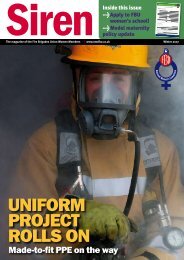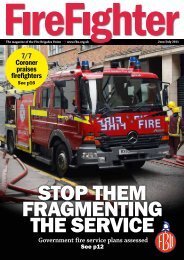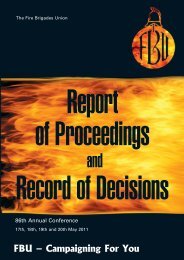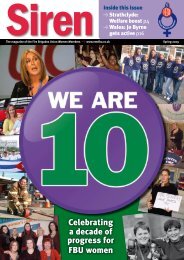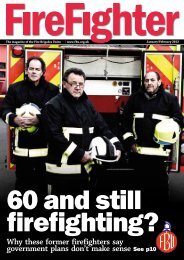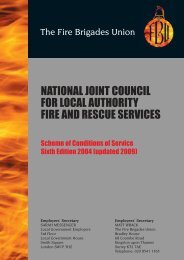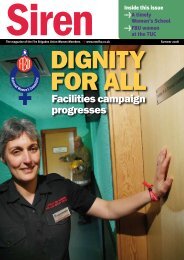Report - Fire Brigades Union
Report - Fire Brigades Union
Report - Fire Brigades Union
Create successful ePaper yourself
Turn your PDF publications into a flip-book with our unique Google optimized e-Paper software.
SECTION J — HEALTH & SAFETY<br />
Indicators and RIDDOR reporting where detailed analysis is<br />
occurring within and across FRSs. This includes regional<br />
comparisons, service comparisons and detailed mining of<br />
data when discrepancies or trends have been discovered.<br />
A spreadsheet has been produced by the group to ensure<br />
all relevant information is captured by each FRS for onward<br />
transmission to CLG. It is imperative that CLG take on<br />
board the information provided on the spreadsheet<br />
because their data will then prove more useful for<br />
comparative and trend-analysis purposes. (To ensure<br />
complete data is entered appropriately, the spreadsheet<br />
will not allow progression if fields are left blank but does<br />
require further refinement).<br />
It is important that the supporting narrative in the Excel<br />
spreadsheet, as piloted by the South West region, is<br />
adopted as it allows dialogue between services and fuller<br />
analysis of each line.<br />
Adoption of this line-by-line annual return will allow CFRAU<br />
and CLG to identify trends and suggest areas that FRSs<br />
should pay specific attention to. (This is in line with their<br />
current practice).<br />
The Excel spreadsheet is not in its final format and merely<br />
indicates the data that this group recommends is collated.<br />
The final format would need to be developed around<br />
‘and/or’ gates in relation to completion of the form. The<br />
analysis and correlation of submitted data is the key to the<br />
design of this particular form.<br />
The form would need to be developed around the<br />
headings of: who is the injured person, what role were<br />
they undertaking, where they were doing it and whether<br />
they were deemed competent or not to do it.<br />
2. Volunteers are classed as “non-employees”<br />
Non-operational volunteers, such as Prince’s Trust<br />
attendees, should not be classed as employees for<br />
reporting purposes. Instead they should be classed as<br />
“members of the public”.<br />
3. FRSs record retained duty system (RDS) personnel<br />
responding to a call as “on-duty”<br />
This group recognises that the recording of RDS<br />
responding to a call is different across the FRSs, CLG and<br />
HSE. For statistical collation however, it is recommended<br />
that all services submit to CLG accidents from the point of<br />
pager actuation.<br />
4. The chemical type be recorded to allow for analysis<br />
and trend identification to occur<br />
Currently there is no national collation of hazardous<br />
substance exposures. However, information is collected<br />
by the HSE who have a RIDDOR category for this with<br />
numbers but not the finer detail e.g. chemical type.<br />
Currently this is an area which has not adequately<br />
evolved and this group would recommend further<br />
research is undertaken – possibly with the Occupational<br />
Health sub-group of CFOA under the HR lead and/or<br />
CFRAU and/or CLG. The form recommended here would<br />
not be the right place to record hazardous substance<br />
exposures which do not result in an immediate identifiable<br />
injury.<br />
5. Employees classed as being “on-duty” or “off-duty” in<br />
relation to (a) sporting events and (b)assisting at<br />
operational duties as a passer-by.<br />
a) Confusion appears to be common when an employee<br />
is injured whilst representing their service at a sporting<br />
event (the cases of representing FRSs at sporting<br />
events is deemed to be with full managerial approval).<br />
The question is, are they on-duty or off-duty at the<br />
point of injury? This group recommends that, if the<br />
person has written permission to represent their<br />
service, they be considered as on-duty.<br />
b) Cases of accidents/injuries by firefighters involved at<br />
operational incidents whilst off-duty should not be<br />
recorded on this form because their involvement is as<br />
a member of the public and not in an on-duty capacity<br />
because invariably they would not have their PPE with<br />
them for instance.<br />
6. Absence statistics are reviewed by a separate task and<br />
finish group undertaking this work<br />
This group believes there is inadequate information<br />
gathered as to the reasons why people are absent from<br />
work. In particular issues with staff that have had a heart<br />
attack or a stroke at work – or not at work (which may be<br />
recorded as a direct result of work activity but not recorded<br />
under accident at work procedures).<br />
The recommendation is that the separate CFRA work<br />
stream look at how to record details of non-accident<br />
fatalities of fire and rescue service employees.<br />
7. A pilot and review of the form and the process be<br />
undertaken in a number of differing FRSs to include<br />
– a metropolitan service, a county council service and a<br />
combined fire authority service<br />
If the recommendations here are accepted then a pilot<br />
and review is required in order to eliminate any<br />
double-reporting or statistical detail contradictions/<br />
anomalies.<br />
8. CLG adopt the new FRS safety statistics data<br />
collection form<br />
This group requests CFOA to champion the new safety<br />
statistics data collection form so it can be adopted by the<br />
Research and Statistics Division of CLG. This will ensure<br />
that the right data recommended by both strategic officers<br />
and practitioners will be collected and then disseminated to<br />
ensure constructive analysis can be undertaken by those<br />
same practitioners and strategic managers.<br />
9. Ensure the right information is entered into the right<br />
boxes for the annual data returns to CLG<br />
All members of this group identified the fact that fire<br />
services complete the annual data returns slightly<br />
differently, which, in turn, compounds data analysis. It is<br />
fundamentally important therefore that the drop-down<br />
menus in the annual returns are absolutely clear and<br />
unambiguous. Furthermore, all FRSs are encouraged to<br />
ensure absolute data quality on submission. CFRAU and<br />
FBU Annual <strong>Report</strong> 2011 163





